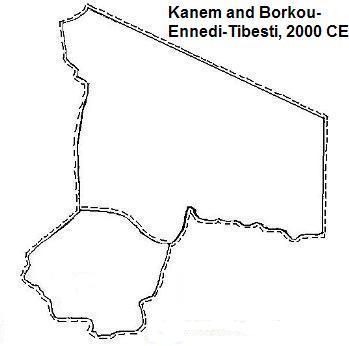1 is scrubland and dry farming. North of that is the Sahara Desert. Just north of the Sahel (desert 'coast') is the Bodele Depression fronted by the Erg (drift sand) of Djourab. East of there is the Ennedi mountains, bounded north by the Depression of Mourdi. The area's northwest includes most of the Tibesti Mountains.
Who lives there?
Just over half speak Dazoga, and another one in twenty speak a closely related language called Tedaga or Teda. Most of the rest speak another Nilo-Saharan language: Kanuri. The Kanuri speakers are usually bilingual in Chadian Arabic but the Dazoga and Tedaga speakers rarely are.
All of them are Sunni Moslems. The largest town is Mao, the prefectural of Kanem with a population of 19 thousand.2
Map

Who was there before?
About ten millenia ago it is said3 that Proto-Nilo-Saharan speakers lived across a swath of Africa from Lake Turkana to the middle Niger, evidenced physically by the 'aquatic tradition.' Among their descendents are the Dazoga, Tedaga and Kanuri speakers. Kanuri was originally confined to near the northeast of Lake Chad. The language spread north into this area and beyond this area to northeast Nigeria when the Empire of Kanem thrived. Two centuries after this kingdom arose to significance it converted to Islam and has remained so for about a millenium. The two capitals of Kanem before the shift into Nigeria were Manan (9th to 11th century CE) and Njimye (11th to 14th century CE).
Around the area
north, from the west
north, from the east
east
south from eastern Bourkou-Ennedi-Tibesti, and east of Kanem
south of Kanem
northwest of Kanem and west of southwestern Bourkou-Ennedi-Tibesti
west of northern Bourkou-Ennedi-Tibesti
Other broad topics
Chad
Footnotes
1. Chad in English.
2. world.gazeetter.com, Chad page, accessed 7/10/2010.
3. By J.E.G. Sutton and Patrick Munson.
